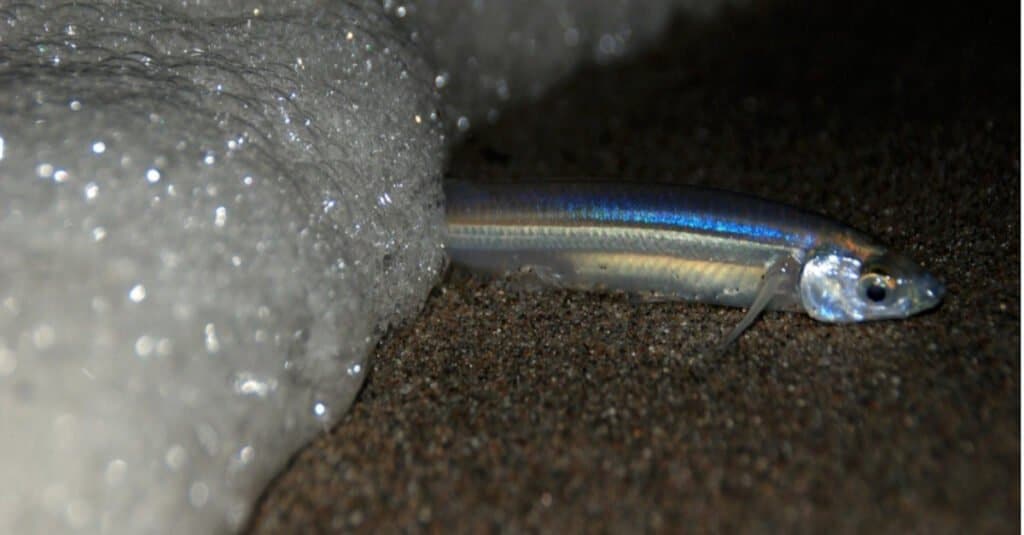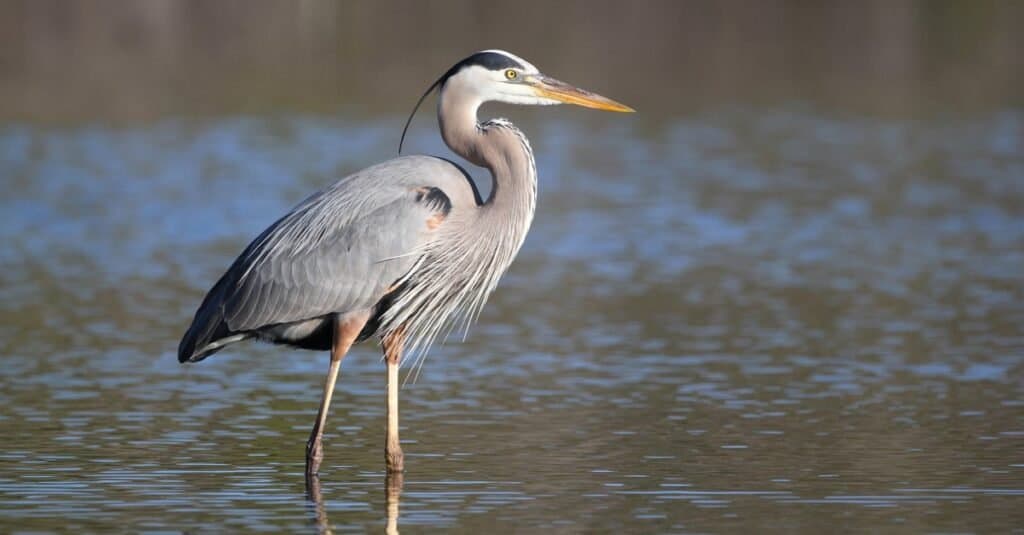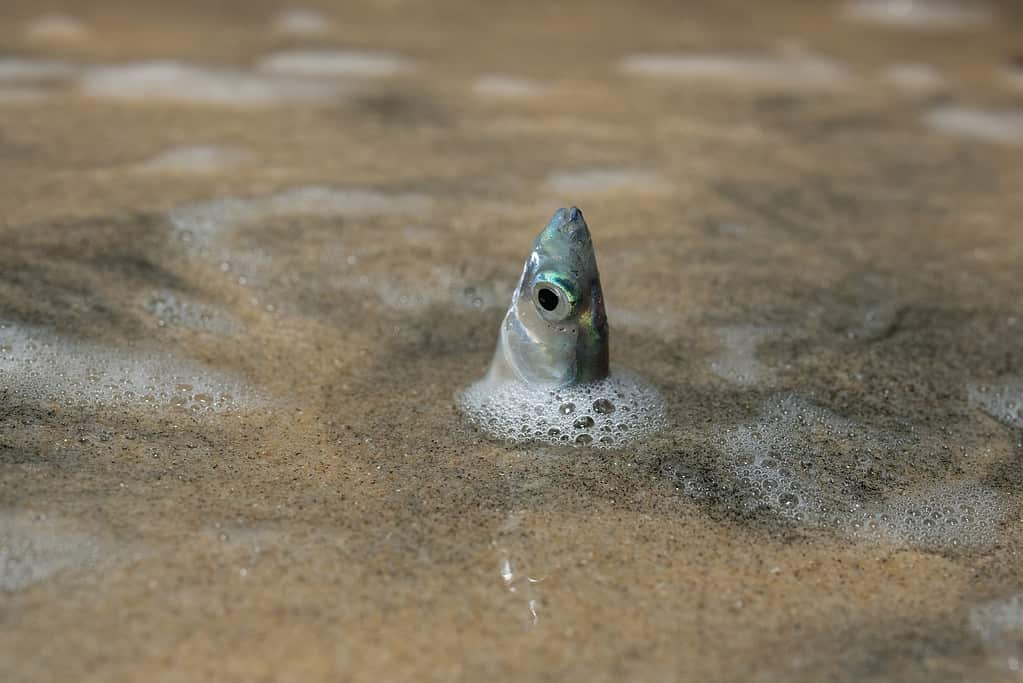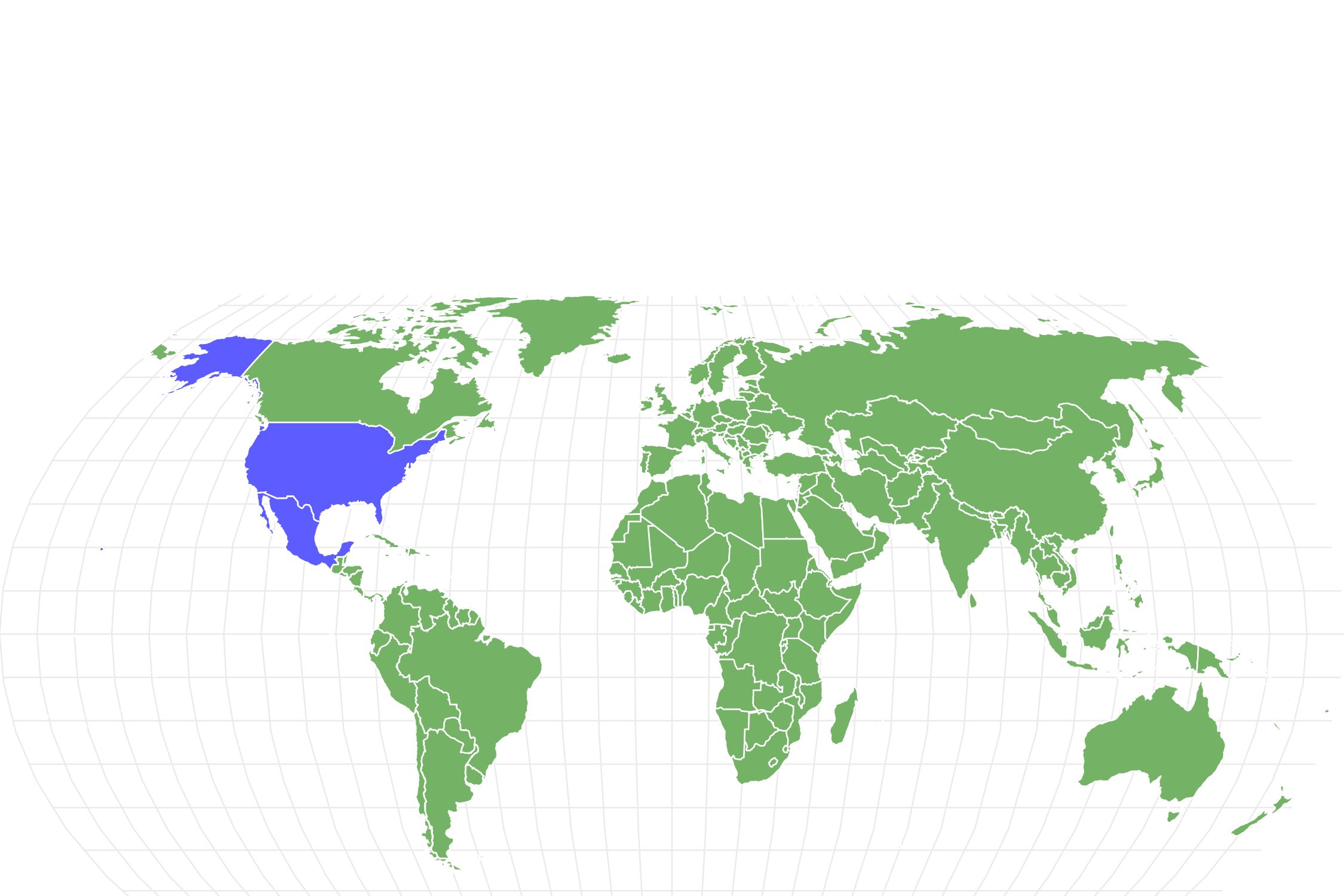Grunion
They strand themselves on beaches to spawn!
Advertisement
Grunion Facts
- Name Of Young
- Fry
- Group Behavior
- School
- Fun Fact
- They strand themselves on beaches to spawn!
- Biggest Threat
- Loss of beach habitat
- Most Distinctive Feature
- Beach spawning
- Incubation Period
- 10 days
- Average Spawn Size
- 1,600 to 3,600 eggs
- Predators
- Larger fish, marine mammals, shorebirds and seabirds, land animals, humans, beetles, flies, sandworms, isopods
- Lifestyle
- Diurnal/Nocturnal
- Number Of Species
- 2
- Slogan
- Their whole bodies are edible
- Group
- School
- Nesting Location
- Beach
Grunion Physical Characteristics
- Color
- Blue
- Green
- Silver
- Skin Type
- Scales
- Age of Sexual Maturity
- One year
- Venomous
- No
- Aggression
- Low
View all of the Grunion images!
Grunions are one of two species of edible marine fish within the genus Leuresthes. These species include the famous California grunion and the lesser-known Gulf grunion. They occur in Pacific waters from California to Baja California. These species participate in a bizarre spawning ritual in which they leave the water to spawn on beaches. The practice of catching these spawning fish by hand is known as a “grunion run.” Both species are small and slender, measuring less than 10 inches in length.
5 Grunion Facts
- Beach spawners: These fish are famous for their strange spawning ritual, which leads them out of the water and onto the beach to spawn. People catch these fish by hand in events known as “grunion runs.”
- Popular food fish: Although they may not be as tasty as other fish, these species are fully edible, including their heads. There are many different ways to prepare them including frying and grilling.
- Egg cannibals: The Californian species often eats the eggs of their own kind. This is called egg cannibalism.
- Illegal to catch with fishing gear: In California, sport fishers may only catch these fish with their hands. In addition to this, they require a fishing license.
- Females dig nests with their tails: Females dig nests in the wet sand with their tails after beaching themselves. They then lay eggs in these nests and wait for males to release their milt into the nests.
Grunion Classification and Scientific Name
Grunions are small marine fish within the genus Leuresthes. The genus name comes from the Greek words leyros (smooth) and esthes (suit/something to wrap) and includes two different species:
- California grunion (Leuresthes tenuis)
- Gulf grunion (Leuresthes sardina)
These fish belong to the family Atherinopsidae (neotropical silversides), a group of approximately 110 species in 13 genera. This family exists within the order Atheriniformes (rainbowfishes and silversides) and the class Actinopterygii (ray-finned fishes).
Grunion Appearance

Grunions have silver colored sides and bellies with a blue-green colored dorsal region.
©iStock.com/Steve Howard
Grunions are long, slender fish with blunt, rounded snouts. Their dorsal regions are bluish-green while their sides and bellies are silvery. Both species are small in size even as adults, weighing less than two ounces. The California variety typically reaches five to six inches in length with a maximum length of eight inches. The Gulf variety grows slightly larger, up to 9.8 inches long. On average, females are slightly larger than males.
Grunion Distribution, Population, and Habitat
Grunions are native to the Pacific Ocean along the western coasts of the United States and Mexico. The Californian species occurs from California in the U.S. to Baja California in Mexico. Its range reaches as far north as Monterey Bay, California and as far south as San Juanico in Mexico. However, most individuals occur between Point Conception, California and Point Abreojos, Mexico. The Gulf species is endemic to Mexico’s Gulf of California (alternately the Sea of Cortés) between the Mexican mainland and the Baja California Peninsula.
These fish occur at depths of up to 60 feet. They remain near shore, which helps facilitate their unusual spawning behaviour on land.
The IUCN does not currently include the Californian species on its Red List. However, it lists Gulf grunions as Near Threatened as of 2007 due to decreasing populations. The greatest threat to these fish is the loss of beach habitats, whether from pollution, erosion, or tourism.
Grunion Evolution and History
Grunions have formed an important part of Native American culture for tribes like the Kumeyaay for hundreds of years. Scientists have discovered fossilized otoliths in California indicating the grunion’s role in these societies. Today, they continue to play a part in Californian and Mexican culture.
These fish have evolved an amphibian-like ability to exist both in the water and (briefly) on land. Compared to other fish, which typically can only survive out of water for about 30 minutes, these species can survive for approximately one hour. Their ability to do so allows them to lay their eggs on land, where they are less susceptible to environmental strains like ocean currents and suffocation. Although this practice is risky for the progenitors, it offers increased viability for the eggs.
Interestingly, there is evidence that the Californian species has evolved a larger egg, including a larger egg yolk, than the Gulf variety. This is likely due to more irregular Californian tides that require a longer incubation period on the beach. For this reason, California grunion eggs survive longer in the sand than do the eggs of their Gulf counterparts.
Grunion Predators and Prey

Shorebirds like herons prey on both adult grunions and their eggs.
©Brian Lasenby/Shutterstock.com
Despite lacking teeth, these fish are carnivorous, feeding off other organisms in the water. Besides humans, they have a number of other predators.
What Do Grunions Eat?
Due to their lack of teeth and small size, these species tend to go after tiny organisms like zooplankton. Scientists have limited data on their feeding habits. However, a recent study suggests that adult California grunions are egg cannibals, feeding on conspecific eggs.
What Eats Grunions?
Predators of these two species include both land animals and larger fish like sharks, halibut, corbina, and guitarfish. They also include dolphins, squids, and sea lions. Shorebirds and seabirds like egrets, herons, and seagulls prey on both adults and eggs. The eggs also frequently fall victim to beetles, flies, sandworms, and isopods.
Grunion Reproduction and Lifespan

Female grunions use their tails to dig nests in the wet sand to lay eggs.
©iStock.com/Kevin McDonald
Grunions are among a few rare species to engage in beach spawning, the practice of leaving the water en masse to spawn on beaches. Peak spawning takes place from late March to early June, though it may occur as early as February or as late as September. The California grunion spawns at night on the four nights during and following a full or new moon, though Gulf grunions also spawn during the day.
During high tide, these fish use incoming waves to swim as far up the beach as they can. After they work themselves onto land, the females use their tails to dig nests in the wet sand. Once they are half-buried in these nests with their heads sticking up, they lay their eggs. Each female can lay between 1,600 and 3,600 eggs depending on their size, with larger females being more productive. Up to eight males then release milt over each female’s body. The milt eventually flows down onto the eggs, fertilizing them.
After spawning, the males immediately head toward the water while the females free themselves from their nests. Females spawn as many as six times in one season, laying their eggs at high tide. Because of this, the eggs have a chance to develop during subsequent lower tides when the water cannot disturb them. After incubating in the moist sand for about 10 days, they hatch during the next high tide and enter the ocean.
Fish belonging to these species mature and spawn for the first time by the end of their first year. At this point, the average male is 4.5 inches long while the average female is five inches long. They typically only live about three years, though some specimens have been known to survive as long as eight years.
Grunions in Fishing and Cooking
The only legal way to fish for grunions in California is to catch them with one’s hands. This policy is in place to preserve present and future populations. As of 2022, sport fishers with a license may pursue and catch up to 30 individual fish during the open season. There is currently no commercial fishing for Leuresthes tenuis in the state. Check out this website for more information on current requirements and open season dates.
Although grunions are popular food fish, they are not as tasty as other species. They are both relatively fatty and an excellent source of omega-3 fatty acids. The entire fish is edible, including the head, though many people remove the head, bones, and innards before consumption. Common ways to cook and eat these fish include grilling, sautéing, broiling, and deep-frying. Grunion tacos are popular in certain areas of California. See this guide for different ways to prepare and cook these species.
Related Animals:
View all 170 animals that start with GGrunion FAQs (Frequently Asked Questions)
Where are grunions found?
These fish inhabit the Pacific Ocean along the western coast of North America from California in the United States to Baja California, Mexico.
Can you eat grunions?
These species are not only edible but are also a popular food fish. The whole body is suitable for consumption, including the head.
Are grunions healthy?
These fish are moderately fatty and an excellent source of omega-3 fatty acids.
Are grunions cannibals?
As egg cannibals, adult California grunions frequently consume conspecific eggs.
Are grunions endangered?
The IUCN does not have data on California grunions. As of 2007, it includes Gulf grunions on its Red List with a status of Near Threatened due to decreasing populations.
Thank you for reading! Have some feedback for us? Contact the AZ Animals editorial team.
Sources
- Britannica, Available here: https://www.britannica.com/animal/grunion
- Fish Base, Available here: https://www.fishbase.se/summary/3239
- Fish Base, Available here: https://www.fishbase.se/summary/13523
- California Department of Fish and Wildlife, Available here: https://wildlife.ca.gov/Fishing/Ocean/Grunion#28352307-faqs--facts
- IUCN Red List, Available here: https://www.iucnredlist.org/species/183267/8083578
- Grunion.org, Available here: http://www.grunion.org/
- Santos, Allison, Frederick, Alyssa, Higgins, B., Carrillo, Andres, Carter, Ariel, Dickson, Kathryn, German, Donovan, Horn, Michael, 2018/06/28 The beach-spawning California grunion Leuresthes tenuis eats and digests conspecific eggs, V93 10.1111/jfb.13734 Journal of Fish Biology, Available here: https://www.researchgate.net/publication/326063847_The_beach-spawning_California_grunion_Leuresthes_tenuis_eats_and_digests_conspecific_eggs
- California Beaches, Available here: https://www.californiabeaches.com/grunion-recipes-how-to-cook-grunion/#:~:text=Cut%20the%20meat%20into%20fillets,for%2010%20to%2015%20minutes.
- Synapse - Boston University, Available here: https://www.bu.edu/synapse/2011/11/22/california-grunions/
- Moffatt, N.M., Thomson, D.A. Tidal influence on the evolution of egg size in the grunions (Leuresthes, Atherinidae). Environ Biol Fish 3, 267–273 (1978)., Available here: https://link.springer.com/article/10.1007/BF00001452
- Grunion.org, Available here: http://grunion.pepperdine.edu/ggproject.htm

















